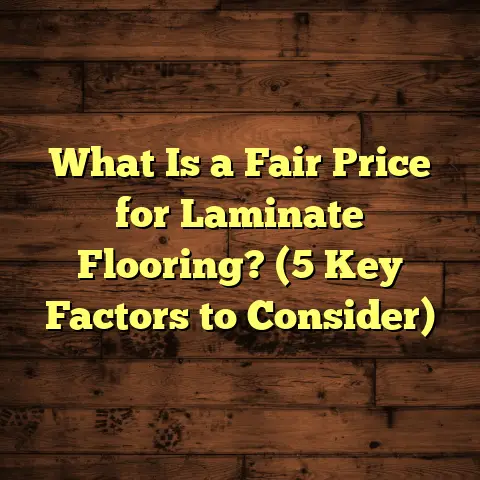What is Linoleum vs Vinyl Flooring? (5 Key Differences Explained)
Adaptability has always been a big selling point for me when choosing flooring options. Over the years, I’ve worked with countless materials, and two that often come up in conversations are linoleum and vinyl flooring. At first glance, they might seem pretty similar — both are resilient, affordable, and come in tons of styles. But when you scratch the surface, the differences between linoleum and vinyl are quite revealing.
What is Linoleum Flooring?
Linoleum is a natural flooring material made primarily from linseed oil, combined with cork dust, wood flour, and natural pigments. It’s been around since the 19th century and was actually one of the first resilient flooring products to gain popularity. What makes linoleum stand out is its eco-friendliness — it’s biodegradable and made from renewable resources.
From my experience, linoleum has this unique feel underfoot. It’s a bit softer and warmer compared to other hard surfaces like tile or vinyl. I’ve installed it in kitchens and playrooms where durability and comfort mattered. The colors and patterns are often more muted than vinyl’s flashy options, but they have a natural charm that blends well in vintage or rustic settings.
Linoleum is also known for being long-lasting — some floors last over 40 years if properly maintained. The surface can be sealed with a protective coating that needs periodic refreshing, but this helps keep it looking good and resistant to stains.
What is Vinyl Flooring?
Vinyl flooring is a synthetic product made from polyvinyl chloride (PVC) resin mixed with other compounds to add flexibility and durability. It appeared later than linoleum but quickly became popular because it was cheaper to produce, easier to install, and came in a wider variety of styles.
Vinyl floors can mimic wood, stone, or tile quite convincingly, thanks to advanced printing technologies. In my work, I’ve seen everything from ultra-thin peel-and-stick sheets to thick luxury vinyl planks (LVP) that feel almost like real hardwood.
One thing I often point out to homeowners is vinyl’s water resistance — it’s generally waterproof, which makes it a top choice for bathrooms, basements, and laundry rooms. Maintenance is straightforward too: simple cleaning with soap and water keeps vinyl looking fresh.
5 Key Differences Between Linoleum and Vinyl Flooring
1. Material Composition and Environmental Impact
Linoleum is made from natural ingredients — linseed oil, cork dust, wood flour — which makes it biodegradable and more environmentally friendly. Vinyl, on the other hand, is petroleum-based plastic containing PVC, which raises concerns about sustainability and chemical emissions.
I remember a client who was very eco-conscious. We chose linoleum because she wanted something “green” that wouldn’t off-gas harmful chemicals. According to the Environmental Protection Agency (EPA), vinyl flooring can emit volatile organic compounds (VOCs), especially when new. Linoleum typically has lower VOC emissions because of its natural makeup.
Statistics show that linoleum’s carbon footprint during production is generally lower than vinyl’s. Plus, at the end of its life cycle, linoleum decomposes naturally without releasing toxic substances — something vinyl cannot claim.
Let me share some numbers here. A study by the European Resilient Flooring Manufacturers Institute (ERFMI) found that producing one square meter of linoleum emits roughly 2 kg of CO2 equivalent gases, whereas vinyl production emits nearly 4 kg of CO2 equivalent per square meter. That’s double the greenhouse gas emissions for vinyl compared to linoleum.
Besides the production footprint, disposal is a big factor too. Linoleum’s natural materials break down in landfills or compost environments within a few years. Vinyl, however, is not biodegradable and often ends up lingering for decades unless recycled properly — and recycling options are limited for PVC products.
2. Durability and Lifespan
When I first started installing flooring, I assumed vinyl would outlast linoleum due to its plastic base. However, I was surprised by how durable linoleum can be when properly cared for. Linoleum floors often last between 20 to 40 years, depending on foot traffic and maintenance.
Vinyl’s lifespan is usually shorter — around 10 to 20 years for most residential products. Luxury vinyl planks can last up to 25 years but will eventually show wear, scratches, or fading.
A case study I followed involved a commercial office renovation where linoleum installed in the 1980s was still in use four decades later after regular waxing and sealing. The same building had vinyl floors replaced every 15 years due to visible wear.
Why does linoleum last longer? It’s largely due to its dense composition and ability to be renewed through refinishing. The surface finish can be buffed and recoated multiple times over its life span. On the other hand, vinyl has a factory-applied wear layer that once worn through means you need to replace the whole plank or sheet.
I recall a project where a retail store owner had a high-traffic linoleum floor that showed minimal signs of wear after 30 years of heavy foot traffic. They simply scheduled periodic maintenance and refinishing every five years to keep it looking fresh.
3. Installation Methods
I’ve installed both types many times, and each has its quirks. Linoleum usually comes in sheets or tiles that require precise cutting and adhesive application. It needs a smooth subfloor because any bumps show through.
Vinyl offers more installation flexibility. There are peel-and-stick options for quick DIY projects and click-lock planks for floating floors that don’t need glue. This makes vinyl more user-friendly for beginners or renters wanting a temporary upgrade.
Linoleum installation tends to be more labor-intensive due to the adhesives and sealing process afterward. I once spent twice the time laying linoleum in a kitchen compared to vinyl in a similar-sized room.
One memorable installation was in an art studio where the client wanted linoleum for its natural look and feel. The subfloor had to be meticulously leveled because any imperfection would telegraph through the material. The adhesive cure time was longer than expected too — patience was key.
Vinyl installation can often be done over existing floors (depending on condition), saving time and money on demolition. This has made vinyl popular among DIYers who want to refresh their space quickly without calling in pros.
4. Maintenance Needs
Linoleum floors require regular sealing or waxing to maintain their protective layer against moisture and stains. Without this care, they can dry out or discolor over time. I’ve advised clients to reapply finish every few years depending on wear.
Vinyl flooring is pretty low-maintenance by comparison. A mop with mild detergent is usually enough. Vinyl doesn’t require sealing because its wear layer protects it naturally.
I recall a busy family home where the owner loved vinyl precisely because spills wiped up easily without worrying about damaging the floor’s surface. Linoleum might have required more attention in that scenario.
However, linoleum can resist bacterial growth naturally due to its organic materials — something vinyl doesn’t boast as much. This makes linoleum popular in healthcare facilities where hygiene is paramount.
If you ever spot scratches on vinyl, they’re harder to fix than on linoleum where buffing can smooth out minor surface damage. But vinyl tends to resist dents better because of its flexible nature.
5. Design Variety and Aesthetic Appeal
Vinyl flooring reigns supreme here for sheer variety. Manufacturers produce endless patterns, textures, and colors — from hyper-realistic wood grains to bold geometric prints.
Linoleum tends to stick with classic or retro styles but has a certain timeless elegance that vinyl sometimes lacks. The colors come from natural pigments embedded in the material; they won’t fade easily but are less flashy.
In my projects, I’ve noticed designers choose linoleum when they want subtlety and warmth, while vinyl fits better where design versatility or budget constraints matter more.
For example, when working with clients aiming for Scandinavian or mid-century modern interiors, I often recommend linoleum for its understated hues like soft greens or muted blues.
Conversely, if someone wants trendy faux marble or bright terrazzo patterns without breaking the bank, vinyl provides endless options at various price points.
My Personal Take on Choosing Between Linoleum and Vinyl
When clients ask me for recommendations, I usually start by asking about their lifestyle:
- How much foot traffic does the floor get?
- Is moisture a concern?
- Do you care about eco-friendliness?
- What’s your budget?
If someone wants a green product that lasts decades with a natural look, I lean toward linoleum. It’s my go-to choice for kitchens or playrooms where comfort matters.
For renters or folks who want easy installation and hassle-free maintenance, vinyl often wins. I’ve installed peel-and-stick vinyl in college apartments where quick setup was more important than longevity.
One interesting project involved an old farmhouse renovation where we used linoleum for its vintage vibe and durability — it ended up being a defining feature of the space.
Unique Insights From My Flooring Experience
- Temperature Sensitivity: Linoleum can feel cooler in winter compared to vinyl. In colder climates, this can impact comfort unless you have radiant heat.
- Allergy Concerns: Because linoleum doesn’t trap dust or allergens as much as carpet or some vinyl surfaces can, it’s often recommended for people with allergies.
- Cost Differences: Typically, linoleum costs between $3-$5 per square foot for materials alone, while vinyl ranges from $2-$7 depending on quality.
- Waste Factors: Linoleum requires careful cutting with minimal waste due to its rigid sheets; vinyl’s peel-and-stick tiles can be more forgiving.
- Repairability: Small damages on linoleum can sometimes be buffed out or patched; vinyl tends to need tile replacement if damaged.
- Sound Absorption: Linoleum absorbs sound better than vinyl due to its natural composition — this is great if noise reduction matters.
- Slip Resistance: Both materials can offer slip-resistant options; linoleum naturally has a bit more grip because of its texture.
- Color Fading: Linoleum resists sunlight fading better; prolonged UV exposure can discolor some vinyl products.
- Off-Gassing: Vinyl floors may emit odors upon installation; linoleum generally smells mild due to natural oils.
- Installation Waste: Because linoleum sheets are cut precisely fitting rooms, waste material can be higher compared with modular vinyl tiles that allow for easier layout adjustments.
Diving Deeper: Case Studies That Highlight These Differences
Case Study 1: The Eco-Friendly Family Kitchen
A family in Portland wanted new kitchen flooring that aligned with their sustainable lifestyle values. They were torn between trendy vinyl planks mimicking hardwood and traditional linoleum tiles with earthy tones.
I brought samples of both into their home so they could feel textures first-hand. The parents were drawn to linoleum’s warmth and matte finish but worried about maintenance demands.
We discussed sealing schedules upfront and I assured them with proper care it would last decades without needing replacement.
They chose linoleum with a protective finish applied professionally by my crew.
Five years later during a follow-up visit, they reported no stains or fading despite having three kids who love cooking messily! They appreciated knowing their floor was biodegradable if ever replaced.
Case Study 2: Urban Apartment Renovation
An interior designer client renovating a small city apartment needed quick turnaround flooring that looked modern but stayed within budget.
Vinyl plank flooring was installed over existing concrete subfloor without adhesives using click-lock technology — saving days on installation time.
The client loved how easy it was to clean after hosting parties and found the waterproof qualities perfect for bathroom and kitchen areas nearby.
However, after about seven years of daily wear from foot traffic plus moving furniture frequently during redecorations, some planks showed scratches requiring partial replacement.
The client accepted this tradeoff given the initial low cost and ease of installation.
Case Study 3: Healthcare Facility Flooring
A mid-sized clinic was looking for resilient flooring that supported hygiene standards but also felt comfortable for patients walking barefoot during therapy sessions.
Linoleum was chosen due to its natural antimicrobial properties and ability to be refinished instead of replaced when worn.
The facility manager noted fewer complaints about cold floors compared to nearby clinics using vinyl.
Over ten years, maintenance budgets stayed steady because deep cleaning routines paired well with periodic resealing rather than full replacements seen with vinyl sections elsewhere.
Technical Data Comparison Table
| Feature | Linoleum | Vinyl |
|---|---|---|
| Material Composition | Natural (linseed oil-based) | Synthetic (PVC-based) |
| Environmental Impact | Biodegradable; low VOCs | Petroleum-based; higher VOCs |
| Average Lifespan | 20-40 years | 10-20 years |
| Installation | Glue-down; precise subfloor prep | Peel-and-stick; click-lock |
| Maintenance | Requires periodic sealing/wax | Low-maintenance (mop & clean) |
| Water Resistance | Water-resistant if sealed | Waterproof |
| Cost per sq.ft | $3 – $5 | $2 – $7 |
| Repairability | Buffable/refinishable | Usually replace damaged piece |
| Design Variety | Limited classic styles | Extensive modern options |
| Comfort Underfoot | Softer & warmer | Firm & cooler |
Frequently Asked Questions From My Experience
Q: Can I install linoleum myself?
A: You can if you have experience with adhesives and precise cutting tools; otherwise hiring pros is safer due to the need for subfloor prep and sealing afterward.
Q: Is vinyl flooring really waterproof?
A: Most modern vinyl products are waterproof but seams need proper sealing in wet areas like showers to prevent water infiltration underneath.
Q: How do I maintain linoleum floors?
A: Regularly clean with pH-neutral cleaners and apply sealant every few years depending on use intensity.
Q: Which is better for pets?
A: Both are pet-friendly but vinyl resists scratches better; however pets are less likely to slip on textured linoleum surfaces.
Q: Are there health concerns?
A: Linoleum releases fewer VOCs making it better indoor air quality-wise; some older vinyl products had higher emissions but newer ones meet strict standards now.
Wrapping Up My Thoughts
Choosing between linoleum and vinyl flooring boils down largely to what you value most — natural materials versus convenience; longevity versus upfront cost; subtle beauty versus design variety; maintenance commitment versus ease of care.
Both have their place depending on your space’s needs:
- Linoleum shines in spaces where eco-friendliness, durability over decades, warmth underfoot, and classic looks matter most.
- Vinyl works well where budget-friendly installation speed matters alongside waterproofing and style flexibility.
Thinking back on all my projects with these materials over the years gives me confidence both choices can serve homeowners well if matched thoughtfully with their lifestyle.
What kind of floor would you pick? Would you go natural with linoleum or synthetic with vinyl? Either way, now you’ve got plenty of info from someone who’s laid down thousands of square feet of both!
If you want more advice tailored specifically for your home or project size — just ask!





